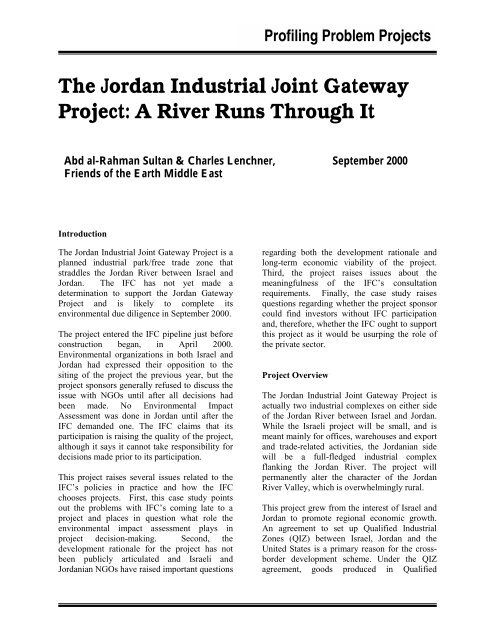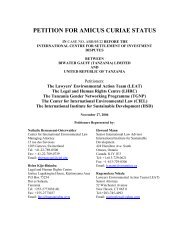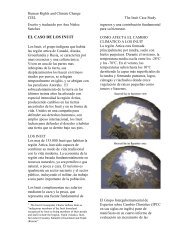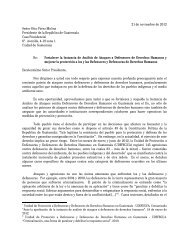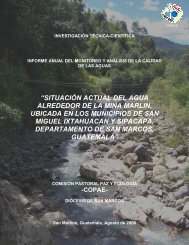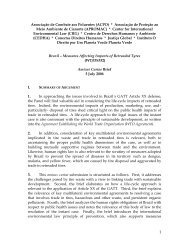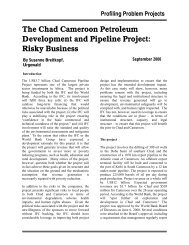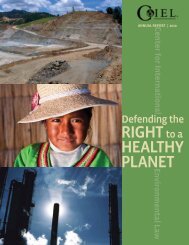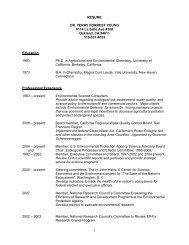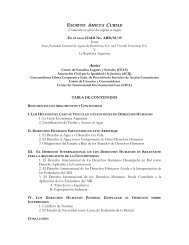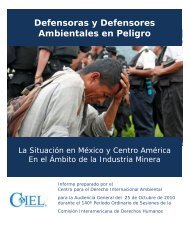The Jordan Industrial Joint Gateway Project: A River Runs Through It
The Jordan Industrial Joint Gateway Project: A River Runs Through It
The Jordan Industrial Joint Gateway Project: A River Runs Through It
- No tags were found...
Create successful ePaper yourself
Turn your PDF publications into a flip-book with our unique Google optimized e-Paper software.
Making the Case for Change<strong>Industrial</strong> Zones in <strong>Jordan</strong>, with a minimumpercentage of value added in Israel, are eligiblefor export to the United States without tariffs.This creates a strong incentive for cross-bordertransactions, as goods go back and forth acrossthe Israeli-<strong>Jordan</strong>ian border in preparation forexport. This sort of joint economic activity hasbeen publicly promoted as a means of creatinggreater economic ties between Israel and <strong>Jordan</strong>that will lead to more normal peaceful relationsbetween the two countries. <strong>The</strong>refore, thesetypes of joint projects enjoy strong politicalbacking in both countries and are supported bymany NGOs.<strong>The</strong> project sponsor is FIBI Investment HouseLtd., which is a subsidiary of FIBI Holdings, theSafra banking group’s business arm in Israel.<strong>The</strong> project is located on the banks of the <strong>Jordan</strong><strong>River</strong>, 8 kilometers south of the Sheikh HusseinBridge. <strong>The</strong> <strong>Jordan</strong>ian side will be more than 50hectares in size to start, with plans for expansionto 127 hectares in the future. <strong>The</strong> project alsoentails the construction of a new bridge between<strong>Jordan</strong> and Israel that will be used to facilitatetrade and export activities.<strong>The</strong> <strong>Jordan</strong>ian part of the enterprise will requirean investment of $30 million. <strong>The</strong> IFC isconsidering a $15 million loan. When complete,the project may employ up to 14,000 <strong>Jordan</strong>ians,with a large percentage of the goods producedtraded through Israel, under the free tradeconditions described above.Overview of Key ProblemsSiting Issues & the Role of the EA.Environmental groups are firmly opposed to thecurrent siting of the project, arguing that the<strong>Jordan</strong> <strong>River</strong> Valley has not been subject toindustrial development and should remain aprimarily agricultural/rural region. <strong>The</strong>se groupsare not opposed to the development of a newindustrial project. On the contrary –environmental organizations in <strong>Jordan</strong> haveopenly expressed support for the aims of thisproject. However, if construction continues atthe current site, the <strong>Jordan</strong> <strong>River</strong> Valley will beirreparably and negatively affected. Both Israeliand <strong>Jordan</strong>ian environmental authorities havediscussed the need for a binational naturereserve along the <strong>Jordan</strong> <strong>River</strong>. NGOs from thethird riparian, the West Bank, have alsoprotested the site, and joined the call for a naturereserve. Allowing this project to move forwardwill make it much more difficult to create such areserve and to preserve the character of thevalley. Planning documents from before 1998make no provision for industrial developmentalong the river, and the <strong>Jordan</strong>ian environmentalauthorities have written a letter urging theirgovernment not to develop industry along theriver banks.In reply to the charge that the environmentalauthorities are generally opposed to <strong>Jordan</strong><strong>River</strong> Valley industrial development, the IFCand project sponsor state correctly that, legallyspeaking, it is the <strong>Jordan</strong> Valley Authoritywhich controls the land, and that all permitshave been secured. In Israel, the Ministry ofEnvironment finally agreed to the projectfollowing intense political pressure on Dalia<strong>It</strong>zik, the Minister of Environment, and a minorsite change. (<strong>The</strong> site on the Israeli side wasmoved away from the banks of the river, to afield a few hundred meters away.) Israel hasactually stated its intention to apply for WorldHeritage status for the <strong>Jordan</strong> <strong>River</strong> Valley fromUNESCO, a decision in line with all planningdocuments that precede 1998, when the projectwas first proposed.Not only will the industrial complex andassociated infrastructure impact the <strong>Jordan</strong> <strong>River</strong>Valley, but they may also lead to additional,unplanned development as people move into thearea for jobs. <strong>The</strong> site is located in a rural area,far from sources of labor, infrastructure andother advantages of an urban location. Whileideally such issues would be considered andaddressed in the environmental assessment,which would in turn inform the decision onsiting, in this case preparation of the EA started2<strong>The</strong> <strong>Jordan</strong> <strong>Industrial</strong> <strong>Joint</strong> <strong>Gateway</strong> <strong>Project</strong>: A <strong>River</strong> <strong>Runs</strong> <strong>Through</strong> <strong>It</strong>
Profiling Problemonly after construction at the current site hadbegun. Since the EA in this case is taking placeafter the onset of construction, it seems unlikelythat the EA will seriously explore alternativessites to the project.Inadequate Consultation. <strong>The</strong> project sponsorhas failed to adequately consult either with localenvironmental organizations or withenvironmental authorities in both Israel and<strong>Jordan</strong> prior to the start of construction.Environmental organizations have beenattempting to engage the sponsor on this issuefor close to 18 months. For most of this time, theproject sponsors have refused to engage indialogue with NGOs. <strong>The</strong> project sponsors havenot only left environmental NGOs out of theprocess, they did not consult with theenvironmental authorities in Israel or <strong>Jordan</strong>until all key planning decisions were made. AnIsraeli official with the Ministry of Trade andIndustry told Friends of the Earth – Middle East(FoEME) that it was an unfortunate mistake thatenvironmental officials were not brought intothe discussion during the planning phase.Unclear Development Rationale. <strong>The</strong> project isdesigned to take advantage of the proximity toIsrael to establish a Qualified <strong>Industrial</strong> Zone(QIZ), as described above. <strong>The</strong> QIZ arrangementallows products manufactured in <strong>Jordan</strong> to beexported to the US under Israel’s Free TradeAgreement with the US – provided that a certainminimum of the value added was in Israel. Thusproducts manufactured in QIZs could beexported to the United States without tariffs,giving industries located in them a clearadvantage.<strong>Jordan</strong> joined the WTO in May. Recently, theUS Trade Representative’s office announcedthat a US – <strong>Jordan</strong> Free Trade Agreement willbe signed by the end of the year. Thus <strong>Jordan</strong>will have free trade status with the United Statesin the future. Against this background, theadvantages of QIZ status are minimized overtime along with a substantial part of the rationalefor a cross-border site. When asked about this inthe Israeli press, the sponsor claimed that the sitestill had border proximity in its favor, ‘takingadvantage of the comparative advantages ofeach country.’ (Globes, June 19). Neither theIFC nor the sponsor have been forthcoming withan explanation of what these ‘comparativeadvantages’ are, why border proximity makes adifference, and how the environmental costsassociated with this site (a new bridge, forexample) outweigh the negative impacts.<strong>The</strong> <strong>Jordan</strong> <strong>Gateway</strong> <strong>Project</strong>, if completed,would not be the only QIZ. Nine other QIZ’s in<strong>Jordan</strong> have been completed or approved, andnone of them are close to the border with Israel.<strong>The</strong> QIZ in Irbid is full, and is undergoing a 50per cent expansion in size. <strong>It</strong> seems that lack ofborder proximity is not a barrier for the potentialtenants of QIZ’s. Furthermore, sites located in ornear urban areas enjoy many advantages – likeaccess to skilled labor – that the <strong>Jordan</strong> <strong>Gateway</strong><strong>Project</strong> site lacks.Finally, NGOs and government planningdocuments have designated the region for touristdevelopment, taking advantage of the area’sheritage and environment. In pursuing industrialdevelopment, the IFC is making a moresustainable course of development harder toachieve.Necessity of IFC Financing. Given that theproject sponsor has begun construction prior tosecuring the IFC loan, it appears that the projectsponsor does not need IFC support in order to goforward with the project. <strong>The</strong> IFC’s limited,publicly-financed resources may be better spenton projects with greater development rationalesthat are truly in need of IFC financing.NGO AdvocacyConstruction began in the face of mountingopposition from all of the major environmentalgroups in the region. Once FoEME learned thatthe IFC was considering a loan, they sent a letterto the IFC alerting them to the project'sproblems. Soon after, letters were sentBy Abd al-Rahman Sultan & Charles Lenchner 3
Making the Case for ChangeFor further information contact:Friends of the Earth Middle East.Charles Lenchner, Abd al-Rahman, International Finance CorporationNeeraj Jain, IFC Investment OfficerEml: Fax: 202-974-4397Niels Vestergaard, IFC Environmental SpecialistEml: Fax: 202-974-43896<strong>The</strong> <strong>Jordan</strong> <strong>Industrial</strong> <strong>Joint</strong> <strong>Gateway</strong> <strong>Project</strong>: A <strong>River</strong> <strong>Runs</strong> <strong>Through</strong> <strong>It</strong>


